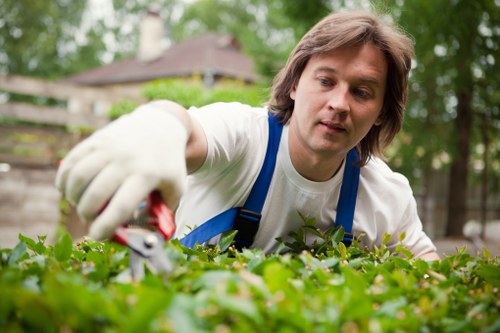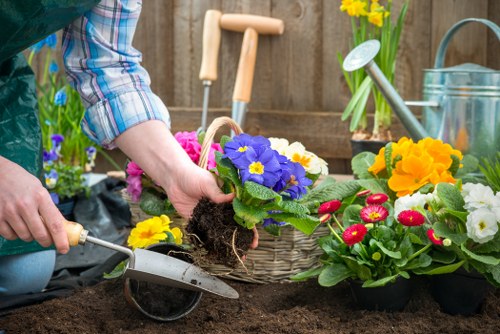Lawn Mowing in Garden Fencing: Enhancing Your Outdoor Space

Introduction to Lawn Mowing and Garden Fencing
Maintaining a beautiful garden involves several crucial elements, and lawn mowing plays a significant role. When paired with garden fencing, the aesthetic appeal and functionality of your outdoor space are greatly enhanced. Lawn mowing in garden fencing ensures that your lawn remains neat, promoting healthy grass growth while your fencing provides structure and privacy.
The combination of regular mowing and well-installed garden fencing not only boosts the curb appeal of your home but also creates a welcoming environment for family and friends. Proper lawn maintenance helps in preventing weed growth and pest infestations, while garden fencing defines boundaries and adds a decorative touch to your landscape.
In this article, we will delve into the best practices for lawn mowing around garden fencing, selecting the right tools, and maintaining both your lawn and fence for long-lasting beauty.

Choosing the Right Lawn Mower for Fenced Gardens
Selecting the appropriate lawn mower is essential for maintaining a healthy and attractive lawn, especially when working around garden fencing. There are various types of mowers available, each with its own advantages. Push mowers are ideal for small to medium-sized lawns, providing precise cutting near fences. In contrast, self-propelled mowers are better suited for larger areas, reducing the physical effort required.
For those seeking eco-friendly options, electric mowers offer a quieter and more sustainable alternative to gas-powered models. Additionally, robotic mowers can automate the mowing process, ensuring consistent maintenance with minimal effort.
When choosing a mower, consider factors such as lawn size, terrain, and the complexity of your garden fencing. A mower with adjustable cutting heights can accommodate different grass lengths, promoting even growth and a well-manicured appearance.

Techniques for Mowing Around Garden Fencing
Mowing around garden fencing requires careful technique to avoid damaging the fence and ensure an even cut. Start by clearing debris and obstacles from the mowing path to prevent accidents and equipment damage. When approaching the fence line, slow down and use shorter, overlapping passes to achieve a clean edge.
Utilize a string trimmer or edging tool for areas where the mower cannot reach, ensuring that the grass is trimmed uniformly along the fence. Maintaining a consistent mowing pattern helps in achieving an aesthetically pleasing result and promotes healthy grass growth.
Regularly inspect your lawn mower blades to ensure they are sharp and free from damage. Dull blades can tear the grass, leading to a ragged appearance and increased susceptibility to pests and diseases.

Benefits of Combining Lawn Mowing with Garden Fencing
Integrating lawn mowing with garden fencing offers numerous benefits for homeowners. A well-maintained lawn creates a lush, green backdrop that complements the style and color of your fencing. Whether you choose wooden, metal, or vinyl fencing, regular mowing ensures that the fence remains a focal point without being overshadowed by overgrown grass.
Moreover, garden fencing provides essential privacy and security, allowing you to enjoy your outdoor space without unwanted intrusions. Properly maintained fencing also serves as a barrier, guiding the growth of your lawn and preventing encroachment from neighboring properties.
The combination of mowing and fencing also facilitates better water management and sunlight exposure for your grass. By defining the boundaries, fencing helps in directing irrigation efforts and ensuring that your lawn receives adequate sunlight, which is vital for healthy growth.

Maintaining Garden Fencing and Lawn Health
To sustain the beauty and functionality of your garden fencing and lawn, regular maintenance is crucial. Start by inspecting your fencing for any signs of wear, damage, or pests. Addressing issues promptly can prevent costly repairs and maintain the integrity of the fence.
For your lawn, establish a consistent mowing schedule based on the grass type and seasonal growth patterns. Avoid cutting more than one-third of the grass height at once to promote resilience and reduce stress on the plants.
Incorporate fertilizing and watering routines to ensure that your lawn remains healthy and vibrant. Proper nutrition and hydration support robust growth, making mowing easier and enhancing the overall appearance of your garden.
Tips for Enhancing Your Lawn and Fence
- Plan Your Mowing Path: Design a mowing pattern that minimizes repetition and promotes even grass growth.
- Use Mulch: Apply grass clippings as mulch to retain moisture and reduce the need for additional fertilizers.
- Seasonal Adjustments: Modify mowing heights and schedules based on seasonal changes to accommodate grass growth variations.
- Fence Styling: Customize your garden fence with decorative elements like climbing plants, lights, or paint to enhance its visual appeal.
- Regular Cleaning: Keep both your lawn and fence free from debris and overgrowth to maintain a polished look.
Common Challenges and Solutions
Maintaining a lawn alongside garden fencing can present various challenges. Uneven grass growth near the fence can result from inconsistent mowing or inadequate sunlight exposure. To address this, ensure that your mower is set to the correct height and adjust the fence placement if possible to allow more light.
Pest Infestations: Pests such as insects and rodents may target your fence or lawn. Implementing natural pest deterrents and maintaining a healthy lawn can mitigate these issues.
Weather Damage: Extreme weather conditions can damage your fencing and grass. Regular inspections and timely repairs help in preventing long-term damage and maintaining the overall health of your outdoor space.
Environmental Considerations
Adopting sustainable practices in lawn mowing and garden fencing contributes to environmental conservation. Opt for eco-friendly mowers that reduce emissions and noise pollution. Additionally, consider using recycled or sustainably sourced materials for your fencing to minimize environmental impact.
Implementing water-efficient irrigation systems and choosing drought-resistant grass varieties can significantly reduce water consumption, promoting a greener and more sustainable garden.
Encouraging biodiversity by planting native species around your lawn and fence enhances the ecosystem, providing habitats for beneficial insects and wildlife.
Cost-Effective Lawn Mowing and Fencing Solutions
Maintaining your lawn and garden fencing doesn't have to break the bank. Investing in quality tools and materials can lead to long-term savings by reducing the need for frequent replacements and repairs. Consider purchasing a versatile lawn mower that can handle various terrains and grass types, ensuring durability and efficiency.
When installing garden fencing, opt for materials that offer the best balance between cost and longevity. Materials such as treated wood, vinyl, and metal each have their own advantages and price points, allowing you to choose based on your budget and aesthetic preferences.
Additionally, regular maintenance practices, such as cleaning and treating your fencing and lawn, can extend the lifespan of both, minimizing the need for costly interventions.
DIY vs. Professional Services
Deciding between DIY lawn mowing and fencing maintenance or hiring professional services depends on your expertise, time, and budget. DIY can be cost-effective and rewarding, allowing you to tailor the maintenance to your specific needs. However, it requires the right tools, knowledge, and commitment to regular upkeep.
On the other hand, hiring professional lawn care and fencing services ensures expert handling of your outdoor maintenance. Professionals bring experience, proper equipment, and efficiency, guaranteeing high-quality results and saving you time.
Consider your personal circumstances and preferences when making this decision. For those with larger gardens or complex fencing structures, professional services might offer the best value and peace of mind.
Conclusion
Integrating lawn mowing with garden fencing is essential for creating and maintaining a beautiful, functional outdoor space. By choosing the right tools, employing effective mowing techniques, and maintaining both your lawn and fence diligently, you can enjoy a vibrant and inviting garden all year round.
Embrace sustainable practices and consider both DIY and professional options to find the best approach for your needs. Remember, a well-kept lawn and sturdy, attractive fencing not only enhance your home's appearance but also contribute to a healthier and more enjoyable living environment.
Ready to transform your garden? Contact us today to book your lawn mowing and fencing service and take the first step towards a stunning outdoor space.